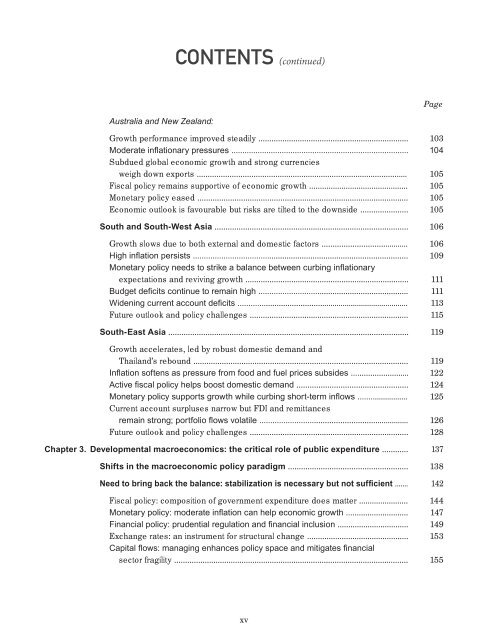Full Report - Subregional Office for East and North-East Asia - escap
Full Report - Subregional Office for East and North-East Asia - escap
Full Report - Subregional Office for East and North-East Asia - escap
You also want an ePaper? Increase the reach of your titles
YUMPU automatically turns print PDFs into web optimized ePapers that Google loves.
CONTENTS (continued)<br />
Page<br />
Australia <strong>and</strong> New Zeal<strong>and</strong>:<br />
Growth per<strong>for</strong>mance improved steadily ..................................................................... 103<br />
Moderate inflationary pressures ................................................................................. 104<br />
Subdued global economic growth <strong>and</strong> strong currencies<br />
weigh down exports ................................................................................................. 105<br />
Fiscal policy remains supportive of economic growth .............................................. 105<br />
Monetary policy eased ................................................................................................. 105<br />
Economic outlook is favourable but risks are tilted to the downside ...................... 105<br />
South <strong>and</strong> South-West <strong>Asia</strong> ......................................................................................... 106<br />
Growth slows due to both external <strong>and</strong> domestic factors ........................................ 106<br />
High inflation persists ................................................................................................... 109<br />
Monetary policy needs to strike a balance between curbing inflationary<br />
expectations <strong>and</strong> reviving growth ........................................................................... 111<br />
Budget deficits continue to remain high ..................................................................... 111<br />
Widening current account deficits ................................................................................. 113<br />
Future outlook <strong>and</strong> policy challenges ......................................................................... 115<br />
South-<strong>East</strong> <strong>Asia</strong> .............................................................................................................. 119<br />
Growth accelerates, led by robust domestic dem<strong>and</strong> <strong>and</strong><br />
Thail<strong>and</strong>’s rebound .................................................................................................. 119<br />
Inflation softens as pressure from food <strong>and</strong> fuel prices subsides ........................... 122<br />
Active fiscal policy helps boost domestic dem<strong>and</strong> ................................................... 124<br />
Monetary policy supports growth while curbing short-term inflows ........................ 125<br />
Current account surpluses narrow but FDI <strong>and</strong> remittances<br />
remain strong; portfolio flows volatile ..................................................................... 126<br />
Future outlook <strong>and</strong> policy challenges ......................................................................... 128<br />
Chapter 3. Developmental macroeconomics: the critical role of public expenditure ............ 137<br />
Shifts in the macroeconomic policy paradigm ....................................................... 138<br />
Need to bring back the balance: stabilization is necessary but not sufficient ....... 142<br />
Fiscal policy: composition of government expenditure does matter ....................... 144<br />
Monetary policy: moderate inflation can help economic growth ............................. 147<br />
Financial policy: prudential regulation <strong>and</strong> financial inclusion ................................. 149<br />
Exchange rates: an instrument <strong>for</strong> structural change ............................................... 153<br />
Capital flows: managing enhances policy space <strong>and</strong> mitigates financial<br />
sector fragility ............................................................................................................ 155<br />
xv












